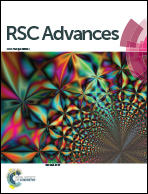Modeling the reactivity of ozone and sulphate radicals towards organic chemicals in water using machine learning approaches†
Abstract
Advanced oxidation process (AOP) based on ozonation and a persulphate/peroxymono-sulphate system, generating reactive sulphate anion radicals (SO4˙−) have widely been employed for the removal of organic contaminants from water and wastewater. Experimental determinations of the rate constants of their reactions with organic compounds in aqueous phase are tedious, time and resource intensive, and development of computational methods has widely been advocated for predicting the reaction rate constants. In this study, we have developed quantitative structure–reactivity relationship (QSRR) models (single decision tree, SDT; and decision treeboost, DTB) for predicting the rate constants (kO3 and kSO4) of reaction of O3 and SO4˙− with diverse organic chemicals in aqueous medium, following the OECD guidelines for QSAR analysis. The constructed QSRR models were validated and their generalization and external predictive power were verified through deriving stringent statistical coefficients. In the test data, the optimal QSRR models (DTB) yielded high correlations (R2 > 0.97) between the experimental and predicted rate constant values for heterogeneous chemicals. The applicability domains of the constructed models were determined by the leverage and standardization approaches. An attempt has been made to provide the mechanistic interpretation of the selected features in QSRR development. The proposed QSRR models outperformed the previous reports. The proposed models can be useful tools in predicting the reactivities of chemicals towards O3 and SO4˙− in the aqueous medium and can provide guidance for designing the AOP systems for water and wastewater decontamination.


 Please wait while we load your content...
Please wait while we load your content...